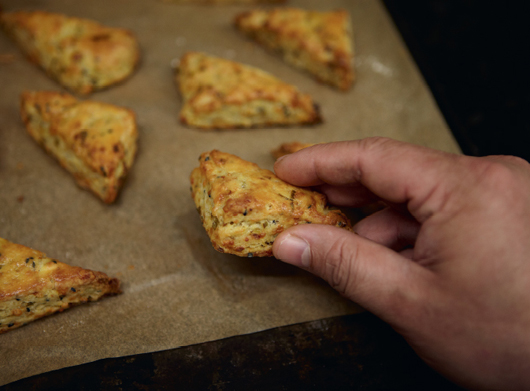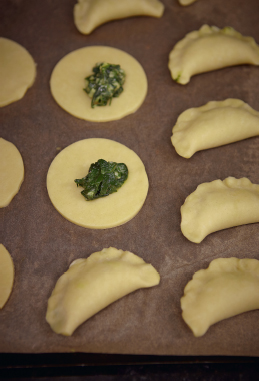Feta & spring onion bouikos
Most mornings in our kitchen, this happens:
- Our pastry chef Giorgia (heavy Italian accent, angry): Sarit! Tell your husband to stop eat my bouikos!
- Itamar (Israeli accent, full mouth): I can eat what I want! Everything here is mine! It’s my restaurant!
- Giorgia (angrier, grabs a rolling pin): The restaurant is yours; the pastry is mine!
- Itamar (reaches for another bouikos): Remember who signs your paycheck!
- Giorgia (bashes his hand with said rolling pin): Sarit signs my paycheck! Go #¡≈†€∞$£@ (Italian swear words)!
- Itamar: %*§¢#¡£@≈† (swear words in Hebrew) Cosa Nostra! £@€*§¢#¡∞ (more swear words in Hebrew)!
Bouikos are little cheese buns from the Balkans. We have had them in our mezze selection almost since day one. They are lovely at room temperature but once you’ve tried them fresh from the oven, you’ll see why it is worth invoking the wrath of the Mafia.
Makes 12 small or 6 large
3 tbsp plus 1 tsp/50g cold butter
3 tbsp/40g mature Cheddar cheese
3 tbsp/40g feta
¾ cup plus 1 tbsp/100g pastry flour
a pinch of salt
¼ cup plus 1 tbsp/50ml sour cream
½ tsp nigella seeds
2 spring onions, chopped (or 2½ tbsp chopped chives)
milk to glaze (optional)
There are two key factors in getting the best texture here: use cold ingredients and work them as little as possible. Cut your cold butter into small cubes the size of playing dice. Grate the Cheddar cheese and crumble the feta, then combine all the ingredients together straight away. You can use a mixer with a paddle attachment or just your hands. Work the mixture until it just combines; lumps of butter and cheese are exactly what you want in this dough—when you bake it, they will melt and ooze and be so tasty.
Place the dough on a lightly floured surface and pat it down to a rough rectangle about ¾–1¼ in/2–3cm thick (roughly the same height as the first joint of your thumb). I traditionally cut it into triangles like this—flour the blade of your knife, cut the dough in half lengthways, slice across three times to divide it into six squares, then cut each of these from corner to corner to give you twelve small triangles. You can also make squares, rounds or rectangles (if you choose to go with rounds, you will need to re-form the offcuts by pushing them together and patting down, so that you use up all the dough). If you want to freeze any for future use, now is the time—lay the dough shapes on a flat tray with a little space between each one and place in the freezer. Once they are fully frozen you can pack them in a container or freezer bag. Just thaw at room temperature for 30–60 minutes before baking.
You can brush the top with a little milk if you want them to be shiny, but it isn’t vital for the flavor. Bake on a lined baking tray on the upper-middle shelf of the oven for 10 minutes. Open the oven and carefully turn the tray round, then reduce the temperature to 400°F and bake for a further 6–8 minutes until they are golden.
You can eat these straight away, or you can cool them on the tray until you are ready to serve. They are best eaten the same day.
Variations
You can vary the flavors if you wish: instead of using spring onion and nigella seeds you could substitute:
• ½ teaspoon of smoky paprika and a pinch of chili flakes; or
• ½ teaspoon of freshly ground black pepper and the leaves from 2 sprigs of thyme.

Borekitas
It took us months to get these just right, but we are so pleased with the result, as they are truly gorgeous. The star here is the pastry. It is known in our kitchen as “dough number 4”—the number assigned to it in the final session of blind tasting, where it was the clear, unanimous winner. The cold, finely diced butter gives it a lovely flake and the heavy cream adds a richness that makes it nearly impossible to resist having another one. There are enough alternative fillings to make a cookbook on their own—burnt eggplant, potato, mushroom, merguez sausage… the list goes on—but this spinach and cheese filling is a good place to start, and also to stop, if you so wish.
Makes about 20
For the pastry dough
10 tbsp/150g cold butter, diced and chilled
⅔ cup/150ml heavy cream
a pinch of salt
a pinch of sugar
2 cups plus 6½ tbsp/300g pastry flour
1 egg yolk
For the filling
3⅓ cups/100g baby spinach, washed
1 egg
1½ oz/40g feta, crumbled
1½ oz/40g kashkaval cheese, grated (or use pecorino)
2½ tbsp chopped dill
3 sprigs of thyme, picked
beaten egg or milk, to glaze
sesame, nigella or poppy seeds, to decorate (optional)
Put all the ingredients for the dough in a large bowl and use the tips of your fingers to bring together (or use a mixer with a paddle attachment). You want small flecks of butter to remain visible—when you come to bake the pastry dough, they will melt and fluff it up to a buttery goodness. Form the dough into a ball, wrap in plastic wrap and rest it in the fridge for at least 1 hour. You can prepare the dough up to 2 days in advance of baking—just keep it wrapped in plastic wrap in the fridge until you need it.
Wilt the spinach in a pan over a high heat—after 1–2 minutes it should have lost its shape but not its color. Quickly remove to a colander to drain. Mix the other filling ingredients together in a bowl. Once the spinach has cooled down a little, press it with the back of a spoon to squeeze out any excess liquid, then remove from the colander and chop roughly. Stir the spinach into the filling mixture and season to taste with salt (but remember that the cheese is salty, so don’t go overboard) and a generous helping of black pepper.
Preheat your oven to 400°F.
Flour your work surface and roll the dough out as thinly as possible. I like to use a 3 in/8cm round cutter to make disk shapes, but you can use a wine glass, or cut the dough into squares if you prefer. Place the dough shapes on a lined baking tray as you go. Re-roll any scraps so that you can keep cutting out shapes, but be aware that the more times you roll it, the less flaky it will be. I discard any leftover pastry dough after rolling it out three times.
Pop a generous teaspoon of filling in the center of each disk (or square) and fold the dough over so that the filling is covered. Use your fingers to pinch the edges of the dough together tightly to seal. If you want to freeze any to bake another day, this is the time to do so—lay the filled pastries on a flat tray with a little space between each one and place in the freezer. Once they are fully frozen you can pack them in a container or freezer bag. They will keep like this for up to a month. All you need to do is take them out of the freezer to thaw at room temperature for an hour before baking.
Brush the borekitas with beaten egg or milk to glaze and sprinkle them with a few seeds (if using—they are more for the look than the flavor). Bake in the center of the oven for 15–20 minutes or until golden. These are best served warm and eaten on the day of baking.

